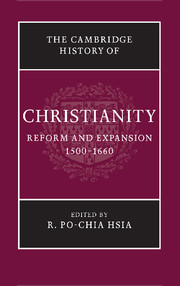Book contents
- Frontmatter
- Part I Luther and the Holy Roman Empire
- Part II The Second Reformation
- Part III Catholic Renewal
- Part IV Resolving Confessional Conflicts
- Part V Religion, Society, and Culture
- 19 The Reformation and the visual arts
- 20 Ritual in early modern Christianity
- 21 Music and religious change
- 22 Demonology, 1500–1660
- 23 Science and religion
- 24 The new clergies
- 25 Women and religious change
- Part VI Christianity and Other Faiths
- Bibliography
- Index
- References
19 - The Reformation and the visual arts
from Part V - Religion, Society, and Culture
Published online by Cambridge University Press: 28 March 2008
- Frontmatter
- Part I Luther and the Holy Roman Empire
- Part II The Second Reformation
- Part III Catholic Renewal
- Part IV Resolving Confessional Conflicts
- Part V Religion, Society, and Culture
- 19 The Reformation and the visual arts
- 20 Ritual in early modern Christianity
- 21 Music and religious change
- 22 Demonology, 1500–1660
- 23 Science and religion
- 24 The new clergies
- 25 Women and religious change
- Part VI Christianity and Other Faiths
- Bibliography
- Index
- References
Summary
The theology of Incarnation and the visual arts
Any consideration of the visual arts in the Reformation must begin with the Incarnation. Throughout their history, Christians have struggled with what it means that, in the words of the Gospel of John, ‘the Word was made flesh’ (1:14, KJV). The Incarnation overthrew the opposition many different schools of classical thought, from the presocratics through the Stoics, had posited: of flesh to spirit, matter to mind. For no Christian could ‘flesh’, or matter, be completely severable from ‘the Word’ or God – the two were bound together in Christ, and to state otherwise was heresy.
The Incarnation also overthrew the Jewish prohibition of images. As both Rome and Constantinople declared during the iconoclastic controversies of the eighth and ninth centuries, if God could take on the flesh, then material representations of Christ in some essential way belonged on a continuum in which matter could serve to make divinity present to the eyes of the faithful. With the rise of the cult of the saints in the high Middle Ages, that continuum came to encompass images of saints, which revealed God’s hand in the lives of Christians after the life of Christ. Thomas Aquinas, explicating the consequences of those pronouncements, explicitly located visual representations on an unbroken line that began with Jesus, then Mary, and then the saints, and ended with man-made visual representations, first of Christ, then Mary, and finally, the saints.
- Type
- Chapter
- Information
- The Cambridge History of Christianity , pp. 343 - 370Publisher: Cambridge University PressPrint publication year: 2007



